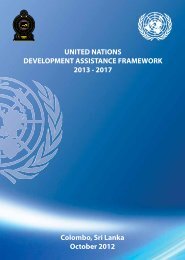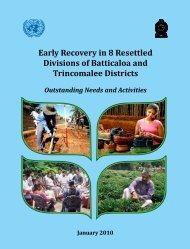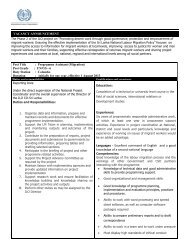Sri Lanka Human Development Report 2012.pdf
Sri Lanka Human Development Report 2012.pdf
Sri Lanka Human Development Report 2012.pdf
Create successful ePaper yourself
Turn your PDF publications into a flip-book with our unique Google optimized e-Paper software.
Male children are generally less likely to attend school at<br />
the higher levels, particularly if they come from poorer<br />
provinces or sectors. For example, at the collegiate level,<br />
the net enrolment for boys from the estate sector is 9<br />
percent compared to 16.7 percent for girls. 154 One reason<br />
could be that boys join the labour market at an early age<br />
due to poverty.<br />
Another challenge comes from extending education to<br />
the most vulnerable groups, including children needing<br />
special education. Some are left out of the formal education<br />
system, such as differently abled children, those with<br />
learning difficulties, street children and children from<br />
deprived socioeconomic backgrounds. A lack of facilities<br />
and specially trained teachers to guide these children,<br />
combines with discriminatory attitudes to discourage their<br />
education. 155 Differently abled children can learn skills and<br />
become more gainfully employed if special educational<br />
facilities and training programmes are available to them.<br />
The availability of school facilities such as science labs<br />
and libraries varies widely across districts (Figure 4.3).<br />
Facilities are poorest in the Kilinochchi, Mannar, Mulativu<br />
and Nuwara Eliya districts, and best in the Colombo,<br />
Galle, Hambantota and Gampaha districts. UNICEF<br />
supports to reduce the number of out of school children<br />
and to provide opportunities for children to get back to<br />
formal schooling. UNICEF’s child friendly approach has<br />
introduced strategies like school attendance committees<br />
which are intended to play a major role in identifying<br />
out of school children. As a result 50 per cent of out-ofschool<br />
children, identified in catchment areas of child<br />
friendly school programme, are estimated to have been<br />
reintegrated in 2011.<br />
Source: UNICEF-<strong>Sri</strong> <strong>Lanka</strong>, n.d., ‘Briefing sheet-Education’,<br />
Figure 4.3: Proportion of Schools with Science Labs and Permanent<br />
library Facilities by District (%), 2010<br />
Note: Secondary schools refer to schools that have classes from years 1–9, 1–11, 1–13, and 7–13.<br />
Source: Computations by the report team of the Institute of Policy Studies of <strong>Sri</strong> <strong>Lanka</strong> using Ministry of Education 2010b.<br />
66<br />
sri lanka <strong>Human</strong> <strong>Development</strong> report 2012






